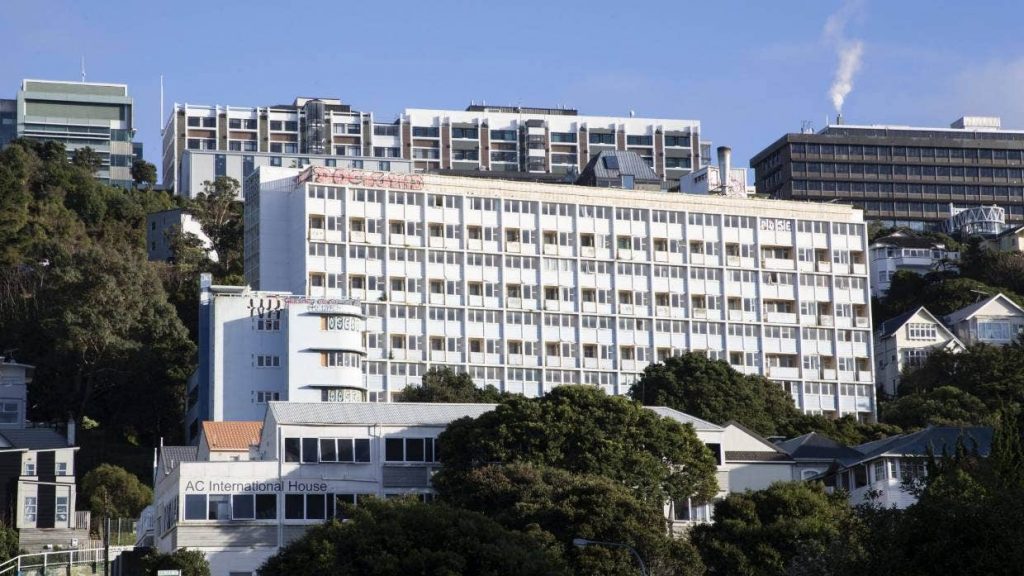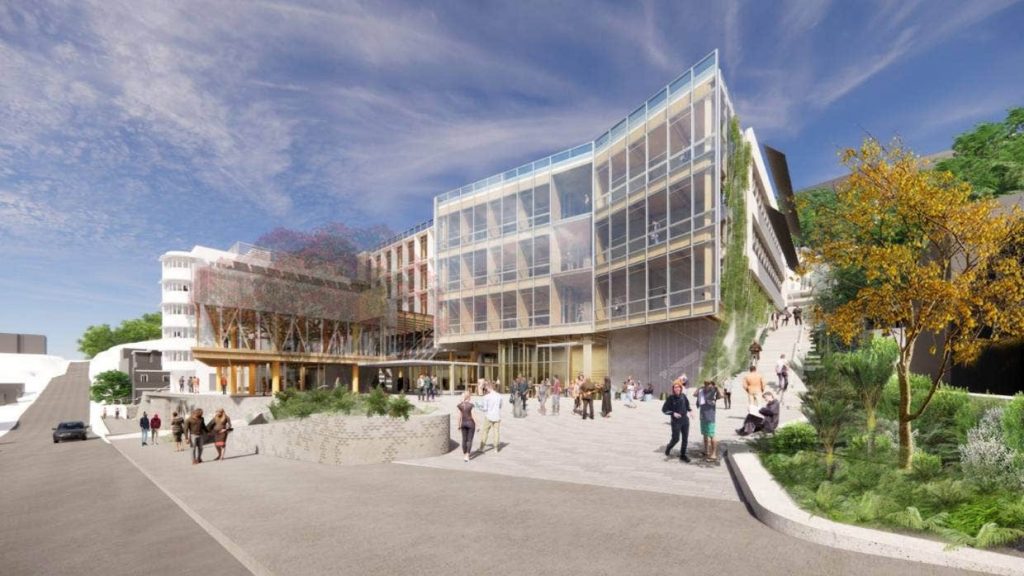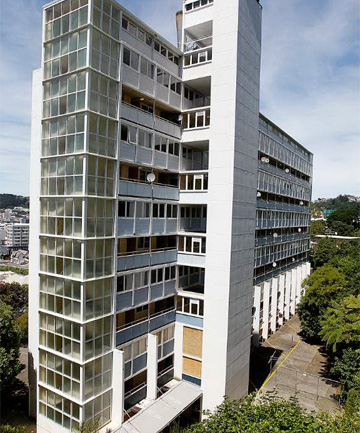Not sure if you realise this yet, but the proverbial cat has just been thrown amongst the proverbial pigeons. Heritage New Zealand Pouhere Taonga (what used to be called the Historic Places Trust) has just announced three new grade 1 heritage listings in Wellington: Trades Hall, Wellington Central Library, and a combined Gordon Wilson and McLean flats as well.
Trades Hall was the site of NZ’s only mystery terrorist bombing – killing Ernie Abbott the caretaker, and probably backfiring by causing more sympathy for unions than the presumed aim of scaring them. It is being listed more for its political and social significance than for it’s architectural significance – its a nice enough 1920s-ish facade and slightly fusty interior, but the real story is the politics.
The Wellington Library building is a bit more controversial due to the current ongoing kerfuffle over who exactly is running the city, and why? Should we sell the Library and then rent it back, or sack the Mayor and all the Councillors? The local architects more or less seem to agree that it is Athfield’s most significant public project and it is certainly one of Wellington’s most interesting and quixotic creations which Levi has talked about before. It is special – very much a building of two different faces, with a wonderfully complex interior. For a building of the 80s or 90s though, it is full of long planks of hollowware concrete floor and – let’s face it – needs upgrading. However, ironically, and Ath himself would be chortling about this: a grade 1 listing would possibly make it more difficult to actually do the seismic upgrading now! Should have got a move on and completed it years ago – now the WCC will be really stuck! Let’s face it: listed buildings ALWAYS take longer and cost more to strengthen and refurbish, than a non-heritage building.

The really big pigeon however – the kereru amongst the palm trees if you wish – is the listing of the Gordon Wilson flats. I’m a huge fan of the 1959 Gordon Wilson flats – they’re very clever with design and space. There is a really good amount of info on the Architectural Centre website – yes, they are still a thing. Yes, they’re run down at present and yes, they need lots of work to the concrete facades – but Vic Uni boss is going to be hopping mad. PVC Grant Guildford simply wants to knock them down. Let the battles commence! The Uni was apparently already working with Athfield Architects to restore the MacLean apartments, although that is on hold it seems – or little progress for the last decade – but Guildford has a bee in his bonnet over the Gordon Wilson flats. It’s a load of stuff and nonsense over them “not being suitable for students” – he just plain doesn’t like them and would prefer to knock them down and start again. The last thing we need is for complete nobodies like the air-headed and architecturally illiterate National MP Nicola Willis getting involved.

The issues that Vic Uni has (apart from it’s ridiculous name-changing efforts that Guildford keeps up with) is that the site would work well for a new entrance for the University. It is frighteningly short of land, having built on every square metre of soil that it possesses, and yet none of it is very grand or publicly visible. Guildford wants a grand front door for the Uni visible from the city, that can provide a route for students to process up and down the hill, connect the other two satellite campuses with the main Kelburn campus, and yet there is this big Modernist slab of apartments in the way. He, like many others in the city, is seeing the building only through very thick, dark glasses, seeing only graffiti and cracked concrete, blocking his view. He’s worried about students throwing things off the building’s many balconies, or perhaps throwing themselves off if their finals are not going quite to plan. Instead, he has a vision of, presumably, grand staircases, escalators, a ziggurat of towers, picturesque vistas of winding students ascending the Potala Palace instead of sitting on a heavily wheezing bus. Perhaps even a new Cable Car.

The Gordon Wilson flats are, however, a goddam architectural marvel. Not only were they a key New Zealand feature in the idiom of world modernism, they also offer a series of lovely interior architectural spaces: double height apartments, with access only every other floor. Once restored and strengthened it can then be used as something more suitable – like student housing (for more grown-up students perhaps), or staff housing, or staff offices, or a music school (let’s face it, this site may work a heck of a lot better than a site wedged in beside the City to Sea bridge), or a school of Classics (no, can’t do that as they’ve just axed all the courses). With a good, visionary architect in hand this could be the grand front door that Guildford wants – an iconic, Modern front door to one of the three universities in this city that call themselves Wellington. A truly apt parking place for waka, pulling up your log of wood, parking your waka in the town before ascending through, alongside, or beside one of the world’s last few really interesting apartment blocks, before the architects of the world got dull and bland and just started putting everyone into boringly similar blocks of space.

Long Live the Gordon Wilson flats!





With regard to Gordon Wilson, While the Heritage NZ decision is certainly helpful in regard to preventing any demolition… I think that is already outweighed by the Environment Court decision that upheld the council’s heritage protection… Any demolition/modification can only come about after council approval, and that door is now very much bolted shut by the Environment Court..
I’m not sure that the Heritage NZ decision would make any difference with respect to preventing demolition – it has no legal force and gives no protection. That is certainly outweighed by council’s listing in the District Plan, which does provide protection (as Another John notes below).
I believe that Victoria University lost their chance to connect properly with Te Aro when the former dental school building in Willis St was crumbling and for sale at a knock-down price in the late 1990s. Rather than create a bridgehead there and backfill with property purchases up to Boyd Wilson Field – especially in the upheaval created by the by-pass – they chose to pepper-pot around the city. The result was confusion and bad blood, first with Wellington Polytech, then with Massey over the joint development of the old NAC building for the School of Architecture and the stretched supply lines down to the railway station for the law faculty.
The university could have connected to its city through Te Aro and Cuba Quarter.
Don’t even get started on the vuw classics department…. the amount of research knowledge lost in the last decade or so in pure research in NZ universities is truly depressing.
One significant difference between the Gordon Wilson Flats + Trades Hall AND the Central Library is that the GW Flats and Trades Hall are already listed on the WCC District Plan (which is the mechanism which already gives them a degree of protection) whereas the Central Library isn’t. Basically the library doesn’t stand a snowball’s chance in hell of being listed on the district plan and nor should it. The last thing the WCC needs are it’s hands tied by rules regarding what it can and cannot do to a building it owns. The building will likely need to be gutted to the point that it will resemble something out of Beirut after the civil war (i.e. a shell) so that the engineering work and service upgrades can happen. One person who would resist very strongly the idea that the central library’s exterior appearance or its internal design & layout should remain fixed, preserved and protected is Ath himself; he always believed that buildings should change and develop as needs and fashions changed (especially if he got the job!). Making the central library a museum piece would be an anathema to him.
Yes, Another John, you’re absolutely right that Ath would be astounded – I remember hearing him sounding stunned and bemused when the WCC ruled that his house / studio / village was a Heritage building. He resisted, until they at last called it Organic Heritage, so that he could keep on working on it…
As the carbon-spewing cement industry slowly is closed down, concrete buildings might well become curious historic anomalies to future generations.
Perhaps they’ll even be prepared to pay for guided tours of concrete-age Wellington.